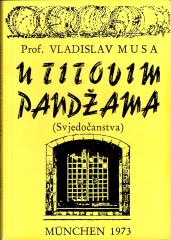
Tumač obćemu austrijskomu gradjanskomu zakoniku I - II
The General Austrian Civil Code, published in 1811, represents the second significant codification of civil law in Europe after the famous French Code Civil from 1804. OGZ in Croatia and Slavonia was introduced in 1852, when imperial patent no. 246.
The General Civil Code, (Allgemeine Bürgerliche Gesetzbuch), which entered into force on January 1, 1812 in all countries that belonged to the Austrian crown at the time, and in other countries of the monarchy according to the chronology given in the previous part of this work, significantly changed the Austrian feudal society as a whole and brought the foundations to reform that society at its roots. These changes did not occur immediately after the beginning of the application of the OGZ in the Austrian lands, but they certainly came about after the revolutionary year of 1848, when the demands of the wider sections of the people in the monarchy and revolutionary influences outside the state forced the political elite to make the necessary changes in the political and legal system. It is said that the OGZ entered into force in certain parts of Istria and Dalmatia, starting on October 1, 1815, and ending on October 1, 1816, in the Karlovac district, on January 1, 1820, which used to be the Kingdom of Illyria, under French administration, to be finally introduced on November 20, 1852, and entered into force in Croatia and Slavonia on May 1, 1853, together with Hungary, Serbian Vojvodina and the Banat of Tamiz.
Nevertheless, the OGZ, as a general and unique civil code, was in use and in force throughout the monarchy for a short time because Hungary succeeded in having the civil code invalidated by the central government in Vienna. The OGZ was in force throughout the Habsburg Monarchy until May 1, 1861, and from that day on, when the imperial and royal judicial districts ceased to operate in Hungary. This was preceded by the so-called October diploma, by which the court of Vienna returned the judicial legislation to the parliament of the lands of the Hungarian crown. According to that decision, by the decision of 20 January 1861, the Hungarian department of the Imperial-Royal Supreme Court and the Supreme Urban Court was dissolved, and the Royal Table of Seven was reorganized. On the basis of this situation, on January 22, 1861, a Judex Curiae conference was opened in Pest, which was composed of septemvirs, all excellent experts in Hungarian law, and their task was to organize an independent Hungarian judiciary, which was also approved by hand royal letter from October 20, 1860.
One of the fundamental features of the OGZ is that, through it, the Croatian legal order established its connection with the continental European legal circle, its subgroup, which is called Central European law, and it is part of the Roman-Germanic legal tradition.68 Already from earlier part of the presentation of this topic, it is evident that this code was unusually important for the entire state, so the rulers also asked the working groups for a special approach to the creation of the basis of the code, and we showed that it was a similar procedure in other states that previously codified private law from Austrian Empire. Due to its importance, the codification of private law, as a kind of chain reaction, caused a whole series of changes and the adoption of new regulations and laws, which may not have a direct connection with private law, and do not refer exclusively to it, but indirectly concern it or they partly regulate relationships in private law as well, and according to their content belong to public law.
OGZ was in force in the territory that was part of the Austro-Hungarian Monarchy and in the first and second Yugoslavia until these regulations from private law were replaced by national ones. The countries where it was valid were Dalmatia and Istria; Croatia and Slavonia; Vojvodina; Slovenia. It was also valid in Lombardy and Veneto (Venice) until the unification of Italy, in the second half of the 19th century. century. It is still in force in the Republic of Austria, amended in 1914-1916.
The book consists of two volumes.
Jedan višetomni primjerak je u ponudi.

- Underlined in pencil

- Damaged back





